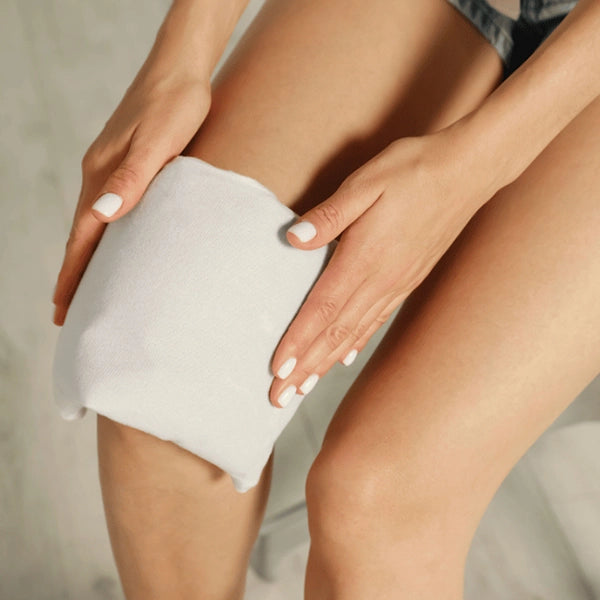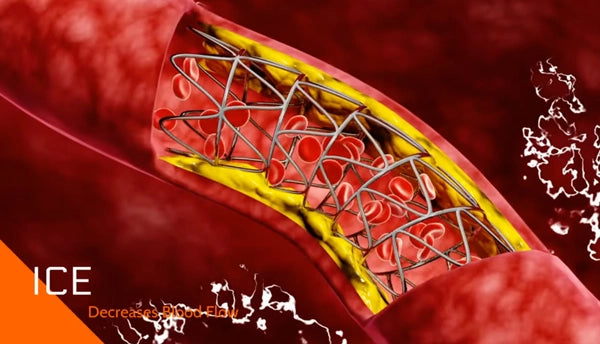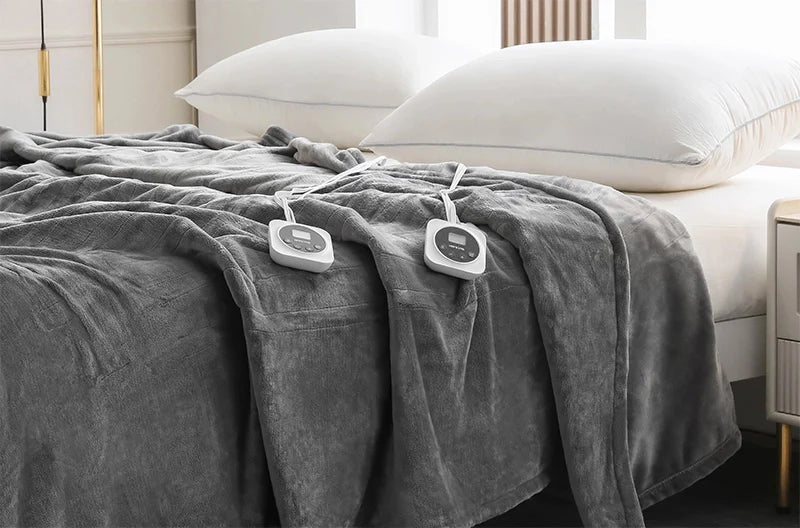Is it Ok to Apply Heat After Knee Replacement?
Picture a scenario in which convalescence with your knee surgery will be as pleasant as a light wind on a hot summer day that wistful idea! As a general rule, we’re forced to pursue common sense. But what if I said there was a secret weapon that most people never really mention? You are on the right track if you are.
Have you ever considered how heat therapy affects your convalescence and recovery from pain? Stick with me, and I’ll reveal what you need to learn about the warm embrace.
So let's get started.
About Knee Replacement Surgery
Knee replacement surgery, or knee arthroplasty, is a procedure to alleviate pain and restore function in a severely damaged knee joint. It involves replacing damaged parts of the joint with artificial components made of metal, plastic, or ceramic materials. This may include replacing the femoral and tibial components, and sometimes the patellar component.
Techniques vary, including traditional open surgery or minimally invasive approaches. Post-surgery, patients undergo physical therapy for recovery, typically experiencing improved pain relief and mobility within weeks to months. While generally safe and effective, knee replacement surgery carries risks such as infection and blood clots, necessitating thorough discussion with healthcare providers. 

When to Introduce Heat Therapy Post-Surgery
Stepping into the world of recovery after a knee replacement, you might wonder about the role of physical therapy in the form of heat. It's a simple question with a layered answer: when do you bring heat into play? The timing is crucial, as introducing heat too early or too late in your recovery process could impact your healing journey.
-
The First 48 Hours: A critical no-heat zone.
-
Why? Early stages see your knee battle acute inflammation. Applying heat can actually increase swelling and bleeding. So, a firm no-go here.
-
-
The Shift After Initial Inflammation:
-
Generally, the curtain rises on heat therapy about two weeks post-surgery.
-
Remember, this isn't set in stone. Your body's healing timeline and your doctor's advice take the lead.
-
-
The Wonders of Heat Therapy:
-
Muscle relaxation and improved blood circulation around the knee.
-
Aids in easing knee pain and facilitates smoother movement, prepping you for physiotherapy.
-
Application: Go for a low to medium temperature for 15 to 20 minutes.
-
In summary, blending heat therapy into your recovery demands patience and precise timing. Keep in lockstep with your healthcare team, allowing their insights to pinpoint when heat becomes your ally in healing.
Do's and Don'ts of Heat After TKR
As you chart your course through the recovery waters post-total knee replacement (TKR), understanding the do's and don'ts of applying heat becomes crucial. Here’s a quick guide to keep you on the right track:
✔️ Do:
-
Check with your healthcare provider before starting heat therapy. Their nod is your green light.
-
Start slow and low: Begin with a low temperature for short durations to gauge how your knee responds.
-
Cover your skin: Always place a cloth or towel between your skin and the heat source to prevent burns. Don't forget to keep your knees straight. While it feels better to be knee-bent, it's safe to keep it straight.
✖️ Don’t:
-
Rush the process: Introducing heat too early can do more harm than good.
-
Overdo it: Keeping heat on your knee for too long can lead to increased swelling and discomfort.
-
Ignore your body's signals: Discomfort or increased swelling is a sign to stop and reassess with your healthcare team.
Remember, the goal of heat therapy in your TKR recovery is to complement your rehabilitation exercises by easing pain and enhancing flexibility.
Why Heat Might Get a Bad Rap and When It's Actually Beneficial
There seems to be some stigma attached to heat therapy in the world of post-knee or joint replacement recovery. However, let’s dispel the stereotypes and find out when heat can be your friend in healing. The myths behind heat therapy:
Heat Causes Swelling
Indeed, heat can make swelling worse when it is too soon for the heat to be applied. However, once the swelling from the initial injury begins to ease, heat can be applied to the site, as it helps to improve circulation and reduce inflammation diseases like deep vein thrombosis (DVT).
Heat Hinders Healing
True, you should not use heat therapy right after surgery. However, the introduction of this method into your plan at the right stage of recovery will speed it up. Heat helps to relax the muscles, which will help with the way they restore their mobility, as well as reduce rigidity and pain.
Heat Works Wonders for Muscle Pain
The reality is that heat therapy has many benefits for the body. The heat will increase the amount of blood going to the injured areas, which means that the tissues will receive more oxygen and blood flow, and the recovery process will be enhanced.
When is heat therapy most helpful? When the initial inflammation is gone – approximately two weeks following the surgery for the physiotherapy sessions, as the heat will help the muscles and joints stretch.
Following Vigorous Workouts
Heat will soothe tense muscles and reduce the pain that comes after exercising. All in all, if you understand the essence behind heat therapy and how to apply it, this tool will help you to make recovery easier and expedite post-knee replacement surgery outcomes.
Can You Use a Heating Pad After Knee Replacement Surgery?
The burning question on many minds post-knee replacement surgery is whether heat therapy, specifically in the form of a heating pad, is safe and beneficial. Let's shed some light on this topic to help you make an informed decision.

The Initial Post-Operative Period
In the immediate aftermath of knee replacement surgery, typically within the first 48 hours, healthcare providers typically advise against using heat therapy, including heating pads, on the surgical site. This caution is primarily due to the risk of increased swelling and bleeding associated with heat application during the acute inflammatory phase.
Timing Is Key
As your knee progresses through the stages of healing and the initial inflammation subsides, usually around two weeks post-surgery, the conversation around heat therapy shifts. At this point, many individuals find that incorporating heat therapy into their recovery routine can provide welcome relief from muscle tension and discomfort.
Using a Heating Pad Safely
If you're considering using a heating pad after knee replacement surgery, it's crucial to do so safely and strategically. Here are some tips to keep in mind:
-
Consult with Your Physical Therapists: Before introducing heat therapy, consult with your surgeon or physical therapist to ensure it's appropriate for your specific situation and stage of recovery.
-
Start Gradually: Begin with short sessions of heat therapy, typically 15 to 20 minutes at a time, using a low to medium temperature setting. Monitor your knee's response and adjust as needed.
-
Protect Your Skin: Always place a cloth or towel between the heating pad and your skin to prevent burns or irritation. Avoid falling asleep while using a heating pad to minimize the risk of prolonged exposure.
While heat therapy, including the use of a heating pad, can offer benefits for some individuals post-knee replacement surgery, it's essential to proceed with caution and follow professional guidance.
Ice vs. Heat: Making the Smart Choice for Your Recovery
In the process of bouncing back from knee replacement1, a common crossroad is choosing between ice and heat. Both have their place, but knowing when and how to use them can significantly influence your recovery speed and comfort.
Ice Therapy: The Go-To for Inflammation
-
Best for: The initial days post-surgery or after a vigorous rehab session.
-
Why? Ice reduces inflammation and numbs the area, relieving pain.
-
How to use: Apply for 20 minutes, ensuring there's a barrier between the ice pack and your skin.

Heat Therapy: The Muscle Relaxer
-
Best for: Once initial swelling has subsided, typically the first few weeks post-op.
-
Why? Heat relaxes muscles and improves blood flow, aiding in pain reduction and flexibility.
-
How to use: A 15-20 minute session with a low to medium heat setting, always with a protective layer over your skin.

Key Takeaways:
-
Listen to your body: It's the best indicator of what you need.
-
Consult your healthcare medical team: They'll provide personalized advice based on your recovery progress.
-
Balance is crucial: Alternating between ice and heat at different recovery stages can offer the best of both worlds.
Understanding the distinct roles of ice and heat in your recovery equips you with the knowledge of pain relief and inflammation effectively. By tuning into your body's needs and following professional guidance, you're setting the stage for a smoother and quicker return to normalcy after total knee replacements.
Proven Strategies for Accelerating Your Knee Replacement Recovery
Recovery following knee replacement surgery2 is a lengthy and challenging process that demands patience and perseverance. Nevertheless, these proven strategies can significantly expedite the healing process, and sooner than later, you will be back on your feet. Here are some scientific ways to fast-track your recovery:
-
Consistently implement your rehabilitation plan by completing physiotherapy exercises. Your knee will benefit greatly from these exercises, as they will help strengthen, mobilize, and enhance its flexibility.

-
Ensure you get enough rest and allow the body to recover after physical activity. Overexerting your knee through activities can result in impediments and even reverse the progress.
-
Eat a balanced diet that supports your knee repair and strengthening. While it does not replace the need for good nutrition, staying hydrated also helps.
-
Use sound discomfort management in combination with ice and heat therapy under the direction of your doctor.
-
Participate in low-intensity activities that encourage blood flow and prevent stiffness, such as walking, swimming, or riding. Choose a demanding exercise that does not put too much pressure on your knee.
-
Follow the post-operative guidelines given by your surgeon, including weight-bearing restrictions and wound maintenance.
These approaches should be part of your daily routine to guarantee you get the most potential results in the shortest period.
Activities and Movements to Avoid for a Smooth Recovery
Throughout your road to full recovery following knee replacement surgery, there are several activities and movements you need to avoid to guarantee a smooth process and successful rehabilitation. These include:
-
High-impact exercises: Running, jumping, or engaging in contact sports should be avoided as they may exert undue pressure on your new knee joint and result in injury.
-
Twisting or pivoting actions: You should avoid abrupt twisting or pivoting on your operated knee since these motions might be too demanding on your knee joint.
-
Deep knee bends: Deep knee bends or squats should be avoided because they place extra mechanical stress on the knees and might harm the soft tissues.
-
Lifting Anything of higher weight: Heavy objects or carrying items that strain your leg muscles should be avoided.
-
Extended periods of standing: Limit the amount of time you spend standing or on your feet, especially during the early phases of recuperation.
-
Unsupported leg extensions: Exercises that involve extending your leg fully or performing unsupported leg extensions should be avoided.
-
Neglecting follow-up care: Avoid missing checkup appointments with your doctor and follow their advice.

Preventive and protective measures help ensure that no issue goes unaddressed during the recovery process. By avoiding the activities mentioned above and ensuring proper post-operative care, one can prevent damage to the knee replacement and promote speedy and successful recovery.
Conclusion: Wrapping Up Your Recovery Journey
As you near the end of your knee replacement recovery journey, pat yourself on the back for the strides you've made. Remember, each step forward, no matter how small, brings you closer to reclaiming your mobility and independence.
Here are the key takeaways from our discussion:
- Timing is crucial: Introduce heat therapy gradually, following the guidance of your healthcare team.
- Listen to your body: Pay attention to its signals and adjust your recovery plan accordingly.
- Balance is key: Alternate between ice and heat therapy for optimal results.
- Follow professional advice: Consult with your healthcare provider before making any significant changes to your recovery routine.
















Leave a comment